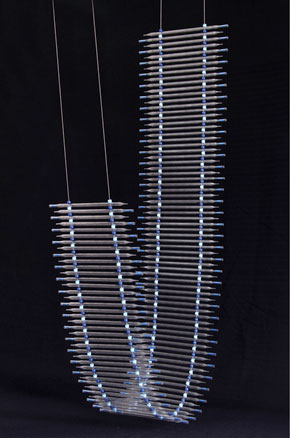 WALDO BRAVO
WALDO BRAVOTrilha 4WALDO BRAVO
Test tubes are essential laboratory research tools. Pipettes and tips can quantify millimetrical measurements to prepare various solutions. And entire universes can be found behind the scientific facets of small bottles.
When in Anita Colli’s hands, these three objects become art. In her experiments with volumes made from waste materials, the artist discovered that scientific equipment can have good chemistry in art galleries or on the living room as well.
Since graduating from the University of São Paulo (USP) in 1965, Anita has worked as a physician. After retiring in 1998, she first devoted herself to painting workshops. She did portraits and abstract paintings, but discovered that she felt more connected with the three-dimensional surfaces.
In 2010, she made her first collages with materials she found at home. The artist keeps pieces made from stove parts, remote controls, thread spools and gas valves, all of which have been treated with red, green and gray monochromatic spray in her collection. Due to their similarity to robots, Anita’s husband Walter ended up giving them an affectionate nickname they still carry today: “killer machines.”
Anita began her exploration with pieces made from wine bottle corks and continued with wire and other scraps from technological equipment. She finally reached the translucent laboratory materials, usually made of plastic with red, green and blue details.
Fixed around one or two axis, the juxtaposition or joining together in a chain of these objects gives rise to forms between the organic and geometric. These pieces are filled with a constructivist heritage. Or, as the curator of her latest exhibition, held in the Unimed Paulistana gallery, Waldo Bravo wrote, “an option for concrete and rational thinking, based on the clustering of multiple objects.”
In Bravo’s opinion, as they are multiplied in Anita’s work, the laboratory parts “also multiply their meanings.” Anita has five main series. Girolos [spinners], with pieces fixed usually around one axis; Anelídeos [annelids], made from round shaped objects fitted into each other; Cirandas [ring a ring a rosy], with tubes articulated at two axes forming circles; Labyrintos [labirinths], generally with spikes fitted onto a fixed support; and Tramas [wefts], resembling shutters.
 WALDO BRAVO
WALDO BRAVOCiranda 1WALDO BRAVO
According to the artist, her initial idea was to “take these objects away from their daily uses, giving them new meaning.” She could not imagine what the result of her exploration would be and continues to be surprised by the associations made by those who come into contact with her art.
In general, these associations indicate organic figurations. “Having spent years working with medicine, this imagery certainly stayed with me,” she says. Although made from geometric volumes, the arrangements may form images similar to, for example, amoebae. Or remind one of skeletons. Or represent DNA sequences. According to Bravo’s analysis, these associations at some point remind us of the work of the Brazilian artist Lygia Clark (1920-1988), who, as from the 1960s, dedicated herself to her famous series named Bichos [animals].
Bravo explains that Clark’s bugs were also made from articulated geometric figures, the difference being that they were metal. The curator also found a common link with the work of the American artist Alexander Calder (1898-1976), famous for his mobile sculptures. Most of Anita’s work can be hung so that it moves with the wind. In the Transformações [transformations] exhibition, the objects were also presented on supports similar to tables. All of them can be manipulated so that the public can reinvent each composition in their own way.
Republish